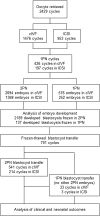Birth of nine normal healthy babies following transfer of blastocysts derived from human single-pronucleate zygotes
- PMID: 26111861
- PMCID: PMC4595390
- DOI: 10.1007/s10815-015-0518-y
Birth of nine normal healthy babies following transfer of blastocysts derived from human single-pronucleate zygotes
Abstract
Purpose: The purpose of this study is to examine the clinical outcomes of blastocysts derived from human single-pronucleate (1PN) embryos after conventional in vitro fertilization (cIVF) and intracytoplasmic sperm injection (ICSI) cycles.
Methods: This was a retrospective study at a reproductive center of a hospital. To evaluate embryo quality and clinical outcomes, cIVF or ICSI cycles with one or more 1PN embryos were compared with same cycles with 2PN embryos (control cycles).
Results: A total of 623 cycles (426 cIVF cycles and 197 ICSI cycles) were treated with cIVF or ICSI. The single pronuclear status rate was similar between cIVF (22.1 %) and ICSI (25.1 %) cycles. Although the development rates of 1PN embryos on day 3 and day 5/6 in cIVF were significantly higher than those in ICSI, those of 1PN embryos in cIVF were significantly lower compared to 2PN embryos (p < 0.01). Nonetheless, the ongoing pregnancy rates achieved with 1PN blastocysts in 1PN embryos did not significantly differ from the control group. Thirty-three transfer cycles with 33 blastocysts derived from 1PN embryos in cIVF resulted in nine deliveries with no newborn malformations; however, no implantation was observed in three ICSI cycles.
Conclusion: Although the blastocyst formation rate of 1PN embryos was significantly lower than 2PN embryos in cIVF and ICSI cycles, 1PN blastocysts in cIVF, and not from ICSI, demonstrated an adequate ongoing pregnancy rate. These results suggested that 1PN blastocysts in cIVF are available for clinical use and may lead to an increase in the chance of pregnancy in patients receiving assisted reproductive technology with 1PN embryos.
Keywords: Blastocyst culture; Clinical outcome; Conventional in vitro fertilization; Intracytoplasmic sperm injection; Normal healthy babies; Single-pronucleate embryos.
Figures
References
-
- Balakier H, Squire J, Casper RF. Characterization of abnormal one pronuclear human oocytes by morphology, cytogenetics and in-situ hybridization. Hum Reprod. 1993;8:402–8. - PubMed
-
- Staessen C, Janssenswillen C, Devroey P, Van Steirteghem AC. Cytogenetic and morphological observations of single pronucleated human oocytes after in-vitro fertilization. Hum Reprod. 1993;8:221–3. - PubMed
MeSH terms
LinkOut - more resources
Full Text Sources
Other Literature Sources


